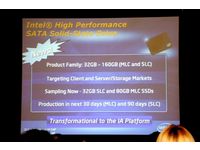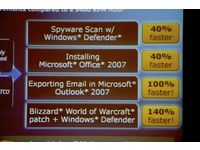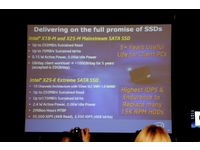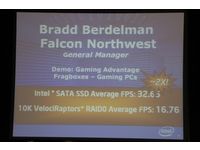IDF: Full Speed Ahead for Intel SSDs
Intel held a media briefing today regarding its solid state drive (SSD) business, outlining speed, size, OEM partnerships, and some tasty benchmark numbers. SSD product line manager Kishore Rao, got the ball rolling by outlining the two types of SSDs Intel would be releasing in the coming months. Intel will be releasing six drives total, two under the Extreme SATA SSD line, and four under the Mainstream SATA SSD name. The Extreme drives will initially come in only the 2.5" size, with 32 and 64 GB flavors. The Mainstream drives will be available in the 2.5" form factor as well, but will also come in the 1.8" size, allowing all those netbooks and ultraportables the kids are crazy about these days to utilize solid state speed without a huge sacrifice on size. Both sizes will come in 80 GB and 160 GB varieties.
Besides capacity, what exactly are the differences? While both the Mainstream and the Extreme drives boast 250 MB/sec. sequential read speeds, the Mainstream “only” writes at 70 MB/sec., in contrast to the 170 MB/sec. write speed of the Extreme drives. Due to the increased speed, the Extreme drives use up to 2.4 watts of power, compared to the unbelievable 0.15 watts used by the Mainstream drives, though both series go down to 0.06 watts when idle. Also, the Extreme series are based on Multi-Level Cell (MLC) technology, whereas the larger Mainstream drives are Single-Level Cell (SLC) based. Finally, the Extreme drives have a two million hour life span, compared to half that for the Mainstream series.
After laying out the drive specs, Rao threw up some impressive benchmarks for the new drives, putting them up against the 5400rpm drives they will most likely be replacing. When running a spyware scan using Windows Defender, the Mainstream drives were 40-percent faster than a 5400 RPM drive. Other numbers include a 40-percent difference in installing Office 2007, a 100-percent difference when exporting email in Outlook 2007, and a hefty 140-percent when running a scan in Windows Defender while simultaneously patching World of Warcraft. The new Intel drives were also put up against several SSD competitors, however no names, sizes or models were listed. Going head-to-head with two competing SSD drives, Intel showed numbers that were almost too impressive to believe, with sequential read speeds anywhere from five times to nineteen times faster, and sequential writes up to eight times faster than the unnamed competition.
Intel ended the presentation with OEM partnership announcements, which included HP, Lenovo and Falcon Northwest. Each OEM appealed to a different aspect of the potential market, starting with HP showing off an Elitebook 2530 equipped with an SSD drive. Walter Fry, one of HP’s senior notebook architects, demonstrated how the new Intel drives handled basic multimedia tasks. Walter took vacation photos and put them into a Google-Picasa slide show and opened iTunes while copying video into a public folder. The SSD-based Elitebook finished the tasks in about 31 seconds, while the magnetic drive still wasn’t finished when the presentation ended. Intel also showed a server setup comparison, putting a server with 36 15,000 RPM drives against one with eight of the Extreme SSD drives, with the SSD-based server supposedly using 98-percent less power, 75-percent less space (an 8U server rack compared to a 2U rack), and six times faster read speeds.
The next demonstration was from Falcon Northwest’s general manager Bradd Berdelman, who showed why SSD drives in gaming rigs can outperform raided 10,000 RPM Velociraptors from Western Digital. Using the same configuration in two of Falcon’s FragBoxes, the SSD drive-based FragBox ran the gaming demo at nearly twice the frame rate as the Velociraptor-based system (32.65 FPS compared to 16.76 FPS). However, as one Australian journalist pointed out, Intel go the numbers mixed up on the slide.
With production on the Mainstream drives starting in a month (Extreme drives in three months), look for Intel to have a big presence in the SSD market right off the bat, and with the manufacturing capacity Intel brings to any market, maybe we will see some lower more reasonable prices before years end.
Get Tom's Hardware's best news and in-depth reviews, straight to your inbox.
-
navvara So the mainstream drives use 0.15 watts when active and 0.6 when idle. Care to explain how?Reply -
scooterlibby How the heck would a drive double the frame rates from a VR? I know you can get some FPS boosts from new drives (from personal experience going from 8mb SATA to 16mb), but I thought the benefit was in load times. A doubling of frame rates I would think usually attributable to the CPU, RAM, and GPU.Reply -
Area51 I have had the fortune of having one of the drives for testing for about 30 days now. So far I am hitting the 250MB/s read and close to 70MB/s write. Its also exceeding 3500 IOPS. I haven’t been able to measure the power because it’s so little that it is with the margin of error.Reply -
one-shot Wait a minute...wouldn't it go up to .6 from .15? I thought that's how numbers worked. Maybe Intel changed that though...Reply -
cushgod ReplyHow the heck would a drive double the frame rates from a VR? I know you can get some FPS boosts from new drives (from personal experience going from 8mb SATA to 16mb), but I thought the benefit was in load times. A doubling of frame rates I would think usually attributable to the CPU, RAM, and GPU.
Yes please if someone could explain this that would rock! Thanks!
And Prices?? How much are we talking .. so as to compare to other SSD's
-
wicko It could be for games that stream textures. But the article says they got the numbers mixed up, so who knows.. I doubt its anything close to double performance.Reply -
rockyjohn Well now I am really confused. The recent article on SSD;s said that highend products used SLC memory and maintstream MLC. Intel does it the other way - their extreme is said to be MLC. Now I am confused about characteristics of both.Reply
http://www.tomshardware.com/reviews/flash-ssd-hard-drive,2000.html
Can anyone "unconfuse" this? -
A little error in the document: the Extreme series are based on SLC technology and the Mainstream on MLC not the way around.Reply
-
TheFace I thought that SLC drives were the faster, more reliable, SSDs. Whereas MLC drives were slower, cheaper and less reliable. Does this article have it backwards?Reply -
GlItCh017 navvaraSo the mainstream drives use 0.15 watts when active and 0.6 when idle. Care to explain how?Reply
I'm curious as well. I was going to say something but you beat everyone to it.



